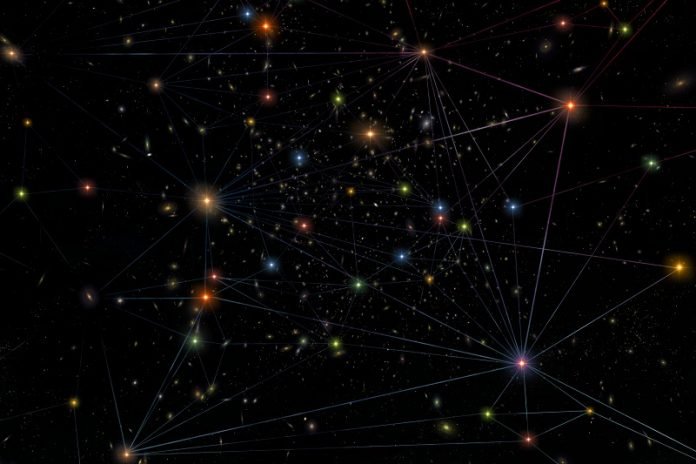
Supermassive black holes are the largest black holes, with masses that can exceed a billion Suns.
Just this spring, the first-ever image of the supermassive black hole at the center of the Messier 87 galaxy was taken, and researchers recently spotted the largest supermassive black hole ever seen.
Despite these groundbreaking efforts, figuring out how these black holes drive a galaxy’s shape and structure continues to be a challenge because most of them are too far away for current telescopes to resolve accurately.
A study published in Nature Astronomy describes a new way to “weigh” supermassive black holes at the centers of galaxies by using distances between neighboring galaxies as a proxy.
The research was a global collaboration involving researchers at institutions in the United Kingdom, Italy, Germany, Chile, and the United States, including Penn faculty Mariangela Bernardi and Ravi Sheth.
Obtaining an accurate estimate of a supermassive black holes’ mass is usually done by measuring the speed of the dust and gas that swirls around it.
This requires extremely sensitive telescopes using a complex analysis, and can only be done for black holes that are large enough to resolve and are relatively close to Earth.
However, if this mass correlates with other properties of the host galaxy, ones that can be measured even when the black hole is smaller or further away, one can use these other properties as “proxies” for mass.
However, explains Bernardi, “We realized there is a bias in the nearby sample that was used to calibrate the masses.
The objects for which we are currently able to measure masses don’t seem to be typical. Our work suggested that supermassive black holes are, on average, not as massive as previously thought.”
To verify this difference in mass, the researchers devised a new and very different way to estimate black hole masses. They used the fact that, while a black hole is surrounded by its host galaxy, the galaxy itself is surrounded by an even larger “halo” made of dark matter.
Galaxies that are surrounded by more massive halos are known to cluster with other large, massive galaxies.
Since more massive black holes exist in more massive galaxies that have more massive halos, the clustering strength actually “weighs” the dark matter halos and, by proxy, the masses of the black holes at their centers.
This new measurement also suggests that supermassive black holes are less massive than previously thought, and could explain why some ongoing experiments haven’t yielded expected results.
As one example, pulsars, remnants of exploded stars, shine like very rapidly spinning lighthouses that spin hundreds of times a second.
Light from pulsars is emitted in incredibly short, regular intervals as the beam sweeps past Earth over and over again.
Researchers are currently looking for gravity waves caused by the collision of two supermassive black holes, which should make these beams bob towards and away from Earth as the wave rushes past and affect the timing of the pulses.
Because the expected shifts have not yet been seen, says Sheth, “People were beginning to worry that maybe gravity is weird, or maybe we don’t fully understand the physics of the mergers that make the gravity waves.
But if the true black hole masses are smaller than previously thought, then the predicted gravity waves would be weaker, making the shifts in pulsar timing harder to detect.”
In the next 10 years, new telescopes are expected to be able to obtain more accurate mass measurements for black holes and to provide an opportunity for researchers to test their new method against larger datasets.
Facilities like the Extremely Large Telescope, a 39-meter scheduled to be finished in 2025, may allow researchers to measure smaller and more distant black holes and their host galaxies directly.
“These findings have significant implications for our understanding of the evolution and growth of supermassive black holes,” says lead author Francesco Shankar.
Bernardi adds that this work will also allow researchers to further study the connection between supermassive black hole growth and the evolution of galaxies.
Written by Erica K. Brockmeier.



